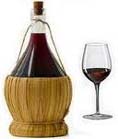Plates - 7
from Italian Traditional Food
Sevres plates
Check out these great Italian ideas at Amazon for Italian food and kitchen ideas.
<< Previous Page 7 Next
>>
Continuing the potted history of plates
....
Sevres porcelain
The history of the famous French
porcelain factory of Sevres really began at Vincennes in 1738. There, the brothers Dubois, two runaway workmen
potters from Chantilly, started a factory under the patronage of a nobleman, Orry de Fulvy. He set them up in a
disused royal chateau, but being a lazy pair, they soon forfeited his confidence and by 1745, a man called Charles
Adam was engaged to "make porcelain in the style of the Saxon". This meant the hard-paste porcelain like that being
manufactured bat Meissen. The French produced instead their delightful, characteristically creamy-white soft-paste,
or pate tendre, as they called it. Very collectable!
In 1747, the factory was granted a
monopoly and in 1753 it was moved to Sevres, conveniently close to the chateau Bellevue, owned by Madame de
Pompadour, and also under the eye of the King, Louis XV. In fact, in 1759, when the factory was producing
quantities of porcelain and had developed lovely colours with which to decorate it, Louis XV bought it for himself
so that he could attach it to the Court.
Development of
colours
Sevres developed a delicate pink
colour called "rose Pompaddour" and a clear blue, "bleu de roi". Both were promptly imitated, as was the painting
in gilt of tiny, mannered flowers on the coloured grounds. Later, in the following century, the English Coalport
factory produced marvellous copies of Sevres porcelain and their new pink, a much deeper shade, was called "rose du
Barry", after the later favourite.
Still at Sevres, costly experiments
went on to develop the hard paste. Kaolin was brought from Limoges bur, despite their best efforts, the new china
took a long time to perfect.
In 1769, the factory mark of a crown
and two crossed L's was added in a vain attempt to check the tide of competitors on the market. Later, plagiarists
added the mark to their copies of plates and some of these were so good that its
impossible to tell the difference. Recently, a vase was offered for sale at a famous London saleroom described by
experts as "Sevres or Minton". It fetched a high price, whichever it was.
Page 8 of this Italian Traditional Food article on plates can be found on the next
page.
<<
Previous Page 7
Next >>

Copyright © 2009 -
. All Rights Reserved Worldwide. Italian Traditional Food
You may not reprint articles from this website
without the written permission of the site owner.
Disclaimer: Articles on this
Website are provided for information purposes only. Italiantraditionalfood.com does not accept any responsibility
or liability for the use or misuse of the article content on this site or reliance by any person on the site's
contents.
| 


 Digg
Digg Stumbleupon
Stumbleupon Google Bookmarks
Google Bookmarks Delicious
Delicious Twitter
Twitter Facebook
Facebook Yahoo My Web
Yahoo My Web Reddit
Reddit